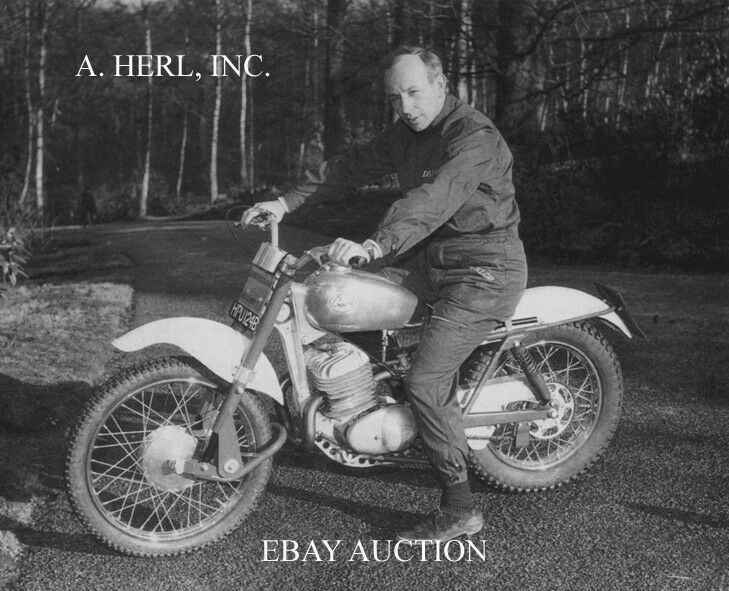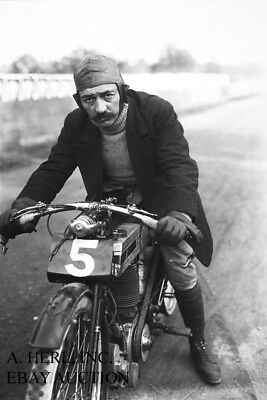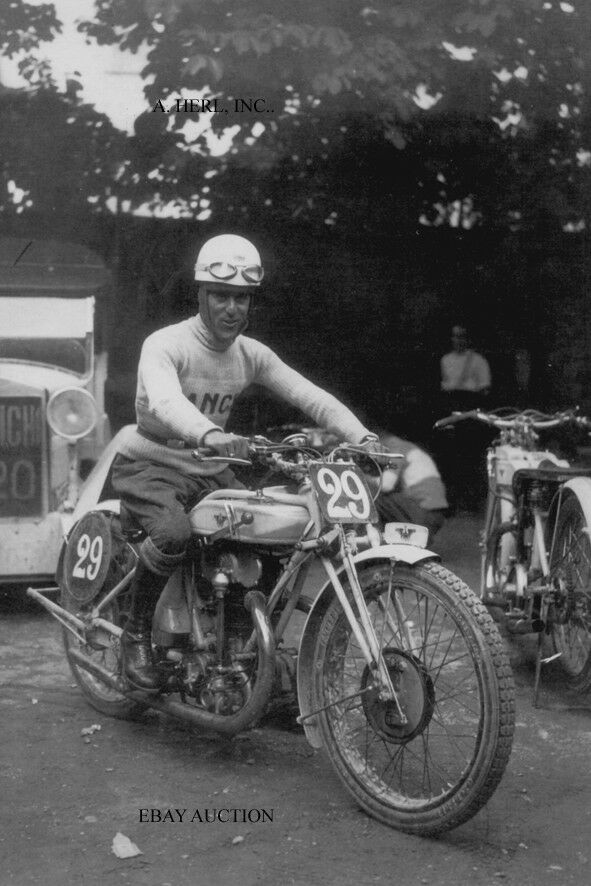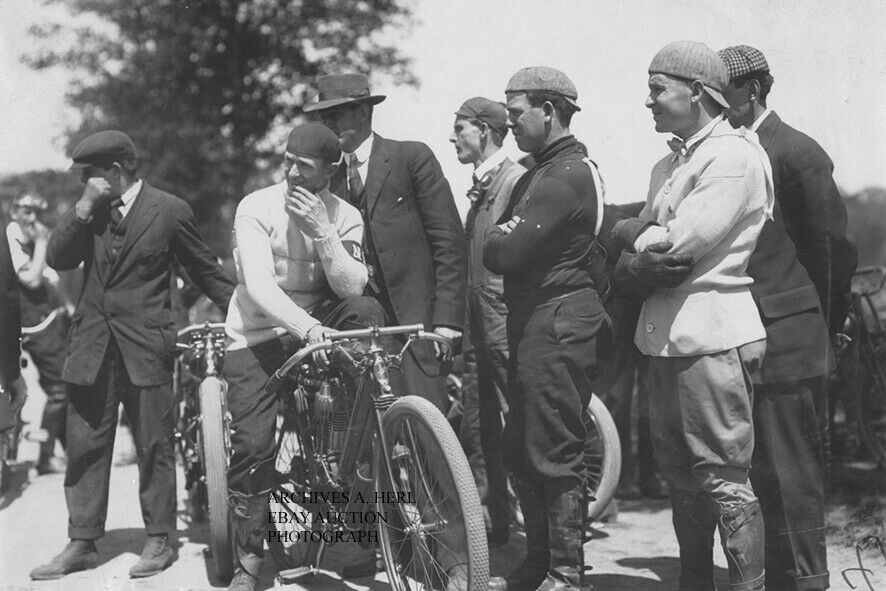-40%
Royal Enfield 750 Interceptor MkI 1967 motorcycle race press photo photograph
$ 5.14
- Description
- Size Guide
Description
A superb and rare photo of the Royal Enfield 750 Interceptor MK1 in 1967!Royal Enfield
was the brand of the Enfield Cycle Company, an English engineering company. Most famous for producing motorcycles, they also produced bicycles, lawnmowers, stationary engines, and even rifle parts for the Royal Small Arms Factory in Enfield Lock. This legacy of weapons manufacture is reflected in the logo, a cannon, and their motto "Made like a gun, goes like a bullet". It also enabled the use of the brand name Royal Enfield from 1890. In 1955 Enfield of India started assembling Bullet motorcycles under licence from
UK
components, and by 1962 were manufacturing complete bikes. The original
Redditch
, Worcestershire-based company dissolved in 1970, but Enfield of India, based in Chennai, continued, and bought the rights to the Royal Enfield name in 1995. Royal
Enfield
production continues, and now Royal Enfield is considered the oldest motorcycle model in the world still in production and Bullet is the longest production run model. About 1890, Townsend got himself into a bit of financial trouble. He called in some financiers from
Birmingham
, but they didn't quite see eye to eye so Townsend parted ways with the financiers leaving the company to them. The financiers then appointed R. W. Smith & Albert Eadie to take control of Townsend's in November 1891. The following year the company was rechristened as "The Eadie Manufacturing Company Ltd". Soon, Albert Eadie got a profitable contract to supply precision rifle parts to the Royal Small Arms Factory in
Enfield
, Middlesex. To celebrate the contract, Eadie and Smith decided to call their new design of bicycle the "
Enfield
". A new company was created to market these new design bicycles called "The Enfield Manufacturing
Co.
Ltd", in October 1892. The next year, the word "Royal" (after the Royal Small Arms Factory) was added to the company name and thus the Royal Enfield began. Their trademark, "Made Like A Gun" appeared in 1893. The first automotive vehicles with the Royal Enfield name were produced in 1898 - a quadricycle with a De Dion-Bouton 2.75 hp engine. This appears to be the first motorised example of what we now refer to as "ATV's" or "Quad's". In 1901 came the Motor Bicycle with a 150 cc 1.5 hp (1 kW) engine above the front wheel. In 1902 a similar contraption appeared with an
Enfield
engine of 239 cc 2.75 hp (2 kW). In 1910 came the first of the famous
Enfield
V-twins, first with Motosacoche 344 cc 2.75 hp (2 kW) engines, later with
Enfield
's own engine. Until World War I the big twins with 770 cc six hp J.A.P. engines and after WWI 976 cc eight hp Vickers-Wolseley engines. In 1915 came the first of the small two stroke 225 cc engines, starting with model 200. The company merged with Alldays & Onions in 1907 and produced cars called Enfield-Allday until 1925. The First World War began in 1914. Royal
Enfield
was called on to supply motorcycles to the British war department and even awarded a contract to build bikes for the Imperial Russian Government during the same period. The machine gun combination and the 6 hp (4.5 kW) stretcher-carrying outfit were some of the models produced for the war purpose.
Enfield
started using its own engines, a 225 cc two-stroke single and a 425 cc V-twin about this time. In 1917, the officers of the woman's police force were issued with a 2.1 RE 2 stroke. The models of this period featured 600 cc, inlet-over-exhaust closed valve gear, hand operated oil pump, two speed countershaft gearbox and chain final drive. The 1915 make in-line 3 cylinder 2 stroke prototype was the world's first with this configuration and engine type. They also made the only known two seater car, the Enfield "Autolette" made in 1914, complete with four cylinder engine with a bore and stroke 59x100mm with a cubic capacity of 1,093 cc. and delivers 9 horsepower (6.7 kW). Other rare examples include the four seater four stroke and a two seater two stroke. The Enfield Autocar Company Ltd. of Hunt End Works in
Redditch
was formed in 1906 to handle the car making activities of the Enfield Cycle Company. In the early 20th century they moved to Sparkbrook after being taken over by Alldays and Onions Ltd. The interwar year was a period when the sidecar reached its zenith. The year 1924 saw the launch of the first
Enfield
four-stroke 350 cc single using a JAP engine. In 1928, Royal Enfield adopted saddle tanks and centre-spring girder front forks, one of the first companies to do so. The bikes now with a modern appearance and comprehensive range, meant continuous sales even during the dark days of depression in
Great Britain
towards the end of 1930. In 1927 Royal Enfield produced a 488 cc with a four speed gear box, a new 225 cc side valve bike in 1928, and a four-stroke single in 1931. Several machines were produced in the next decade, from a tiny two stroke 146 cc Cycar to an 1140 cc V-twin in 1937. Royal
Enfield
's range of bikes for 1930 consisted of 13 models. During World War II, The Enfield Cycle Company was called upon by the British authorities to develop and manufacture military motorcycles. The models produced for the military were the WD/C 350 cc sidevalve, WD/CO 350 cc OHV, WD/D 250 cc SV, WD/G 350 cc OHV and WD/L 570 cc SV. The most well known offering beyond doubt was the Flying Flea aka the Airborne. This lightweight 125 cc bike could be dropped by parachute along with airborne troops. The factory also manufactured a variety of special instruments and apparatuses to use against enemy forces during war. In 1931, a four-valve, single-cylinder was introduced and christened "Bullet" in 1932. It had an inclined engine and an exposed valve gear. It was the very first use of the now famous Bullet name. In the late 1950s and early 1960s, Royal Enfield produced a number of 250 cc machines. The biggest selling of these was the Royal Enfield Crusader, a 248 cc pushrod OHV single producing 18 bhp (13 kW). In 1965 a 21 bhp (16 kW) variant called the GT Continental, with
GRP
tank, 5 speed gearbox (which was also an option on the Crusader), clip-on handlebars and rearset footrests was launched. It sold well with its "cafe racer" looks. Other variants were the 250 "Turbo Twin" fitted with the Villiers 247 twin two-stroke engine. An oddity was the 250 Clipper, mainly notable for its use of trailing-link front suspension (all the other 250s had conventional telescopic forks). During the onslaught of the Japanese motorcycle manufacturers in the late sixties and early seventies, the English factories made a final attempt with the 1962 - 1968, series I and Series II. Made largely for the
US
market, it sported lots of chrome and an engine performance with less than 14 seconds to the quarter mile at speeds well above 175 km/h (105 mph). It became very popular in the
US
, but the classic mistake of not being able to supply this demand, added to the demise of this last English made Royal Enfield. The
Redditch
factory ceased production in 1967 and the
Bradford-on-Avon
factory closed in 1970, which meant the end of the British Royal Enfield. After the factory closed a little over 200 Series II Interceptor engines were stranded at the dock in 1970. These engines had been on their way to Floyd Clymer in the
US
, who unfortunately had just died. His export agents, Mitchell's of
Birmingham
, were left to dispose of them. They approached the Rickman brothers for a frame. The main problem of the Rickman brothers had always been engine supplies, so a limited run of Rickman Interceptors were promptly built. As far as the motorcycle brand goes though, it would appear that Royal Enfield is the only motorcycle brand to span three centuries, and still going, with continuous production. A few of the original
Redditch
factory buildings remain (2006) and are part of the Enfield Industrial Estate. From 1955 to 1960 Royal Enfields were painted red, and marketed in the
USA
as Indian Motorcycles by the Brockhouse Corporation, who had acquired the rights to the Indian name after it went under in 1953. Floyd Clymer, of manual fame, was involved, but Americans were not impressed by the badge engineering, and the venture was unsuccessful. It was rather ironic that Enfields went 'Indian' in two different ways. The largest
Enfield
"Indian" was a 700 cc. The marketing agreement expired in 1960 and from 1961 Royal Enfields were available in the
US
, still through Clymer, but under their own name, up until Clymer's death in 1970. Royal Enfields had been sold in
India
from 1949. In 1955, the Indian government looked for a suitable motorcycle for its police and army, for use patrolling the country's border. The Bullet was chosen as the most suitable bike for the job. The Indian government ordered 800 350 cc model Bullets, an enormous order for the time. In 1955 the
Redditch
company partnered Madras Motors in
India
in forming '
Enfield
India
' to assemble, under licence, the 350 cc Royal Enfield Bullet motorcycle in
Madras
(now called Chennai). Under Indian law, Madras Motors owned the majority (over 50%) of shares in the Company. In 1957 tooling equipment was sold to
Enfield
India
so that they could manufacture components. The first machines were assembled entirely from components shipped from
England
, but by 1962 all components were made in
India
.
This is a very nice and very rare
non period
photo that reflects a wonderful era of 1950s motorcycle history in a wonderful way. This is your rare chance to own this photo, therefore it is printed in a nice large format of ca. 8" x 11" (ca. 20 x 28 cm). It makes it perfectly suitable for framing!
Shipping costs will only be $ 7.00 regardless of how many photos you buy. For 5 or more photos, shipping is free!
(Note: A. Herl, Inc. does not appear on photo, for ebay purposes only)
No copyright expressed or implied. Sold as collectable item only. We are clearing out our archives that we have gathered from various sources.
All items always sent well protected in PVC clear files
and board backed envelopes.
We have photographs that came from professional collections and/or were bought from the original photographer or press studio! They are all of professional and excellent quality.
After many decades of professionally collecting photographs and posters we are clearing out our archives. They make the perfect gift and are perfectly suited for framing. They will look gorgeous unframed and will be a true asset nicely framed with a border. They are a gorgeous and great asset in every home, workshop, workplace, restaurant, bar or club!
First come - first served. And you can always contact us for your requests. Please ask any questions before the auction ends.









